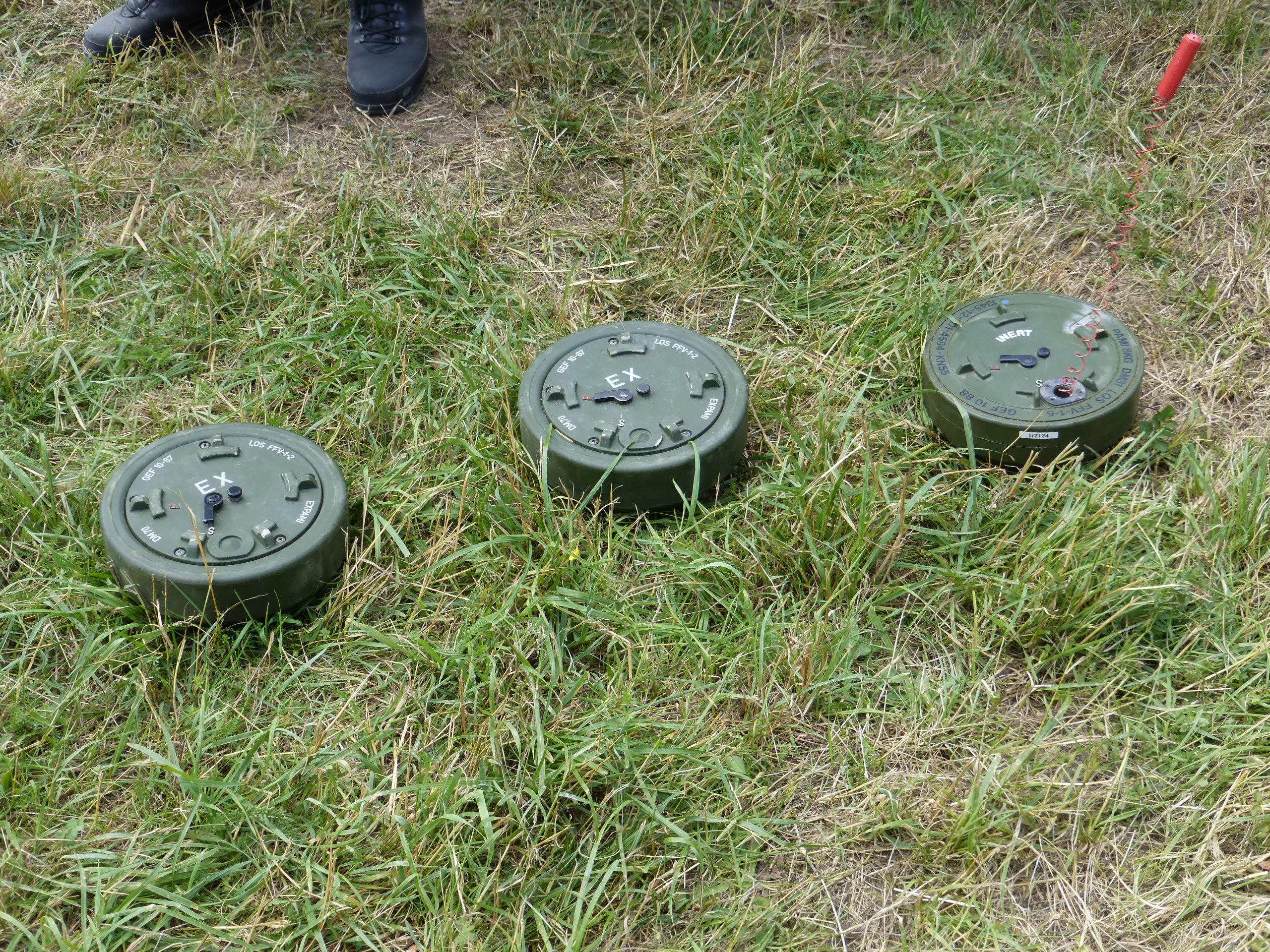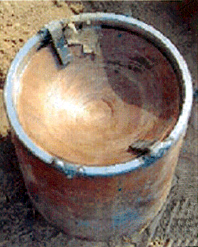|
FFV 028 Mine
The FFV 028 is a series of steel cased Swedish anti-tank mines that use electronic fuzes. The mines are circular, with a large Misznay Schardin effect warhead in the center of the mine, with the fuzing and sensor electronics located in the dead space above the main charge. The design of the mine dates from the 1970s and uses a magnetic influence sensor to detonate the mine, making it able to attack the full width of armoured vehicles. The mine can be laid either by hand or by a mechanical mine laying system. Once the mine is emplaced, a pre-set arming delay of up to 60 minutes is initiated, after which the magnetic sensor activates and will trigger the mine if a target passes overhead. When the mine is triggered, a small clearing charge blows away any material that may have been on top of the mine, followed a fraction of a second later by detonation of the main explosive charge. The main charge creates an explosively formed penetrator which is capable of penetrating the belly ar ... [...More Info...] [...Related Items...] OR: [Wikipedia] [Google] [Baidu] |
Anti-tank Mine
An anti-tank mine (abbreviated to "AT mine") is a type of land mine designed to damage or destroy vehicles including tanks and armored fighting vehicles. Compared to anti-personnel mines, anti-tank mines typically have a much larger explosive charge, and a fuze designed to be triggered by vehicles or, in some cases, remotely or by tampering with the mine. History First World War The first anti-tank mines were improvised during the First World War as a countermeasure against the first tanks introduced by the British towards the end of the war. Initially they were nothing more than a buried high-explosive shell or mortar bomb with its fuze upright. Later, purpose-built mines were developed, including the Flachmine 17, which was simply a wooden box packed with explosives and triggered either remotely or by a pressure fuze. By the end of the war, the Germans had developed row mining techniques, and mines accounted for 15% of U.S. tank casualties during the Battle of Saint-Mih ... [...More Info...] [...Related Items...] OR: [Wikipedia] [Google] [Baidu] |
Fuze
In military munitions, a fuze (sometimes fuse) is the part of the device that initiates function. In some applications, such as torpedoes, a fuze may be identified by function as the exploder. The relative complexity of even the earliest fuze designs can be seen in cutaway diagrams. A fuze is a device that detonates a munition's explosive material under specified conditions. In addition, a fuze will have safety and arming mechanisms that protect users from premature or accidental detonation. For example, an artillery fuze's battery is activated by the high acceleration of cannon launch, and the fuze must be spinning rapidly before it will function. "Complete bore safety" can be achieved with mechanical shutters that isolate the detonator from the main charge until the shell is fired. A fuze may contain only the electronic or mechanical elements necessary to signal or actuate the detonator, but some fuzes contain a small amount of primary explosive to initiate the detonation. ... [...More Info...] [...Related Items...] OR: [Wikipedia] [Google] [Baidu] |
Magnetic
Magnetism is the class of physical attributes that are mediated by a magnetic field, which refers to the capacity to induce attractive and repulsive phenomena in other entities. Electric currents and the magnetic moments of elementary particles give rise to a magnetic field, which acts on other currents and magnetic moments. Magnetism is one aspect of the combined phenomena of electromagnetism. The most familiar effects occur in ferromagnetic materials, which are strongly attracted by magnetic fields and can be magnetized to become permanent magnets, producing magnetic fields themselves. Demagnetizing a magnet is also possible. Only a few substances are ferromagnetic; the most common ones are iron, cobalt, and nickel and their alloys. The rare-earth metals neodymium and samarium are less common examples. The prefix ' refers to iron because permanent magnetism was first observed in lodestone, a form of natural iron ore called magnetite, Fe3O4. All substances exhibit some type ... [...More Info...] [...Related Items...] OR: [Wikipedia] [Google] [Baidu] |
Detonate
Detonation () is a type of combustion involving a supersonic exothermic front accelerating through a medium that eventually drives a shock front propagating directly in front of it. Detonations propagate supersonically through shock waves with speeds in the range of 1 km/sec and differ from deflagrations which have subsonic flame speeds in the range of 1 m/sec. Detonations occur in both conventional solid and liquid explosives, as well as in reactive gases. The velocity of detonation in solid and liquid explosives is much higher than that in gaseous ones, which allows the wave system to be observed with greater detail (higher resolution). A very wide variety of fuels may occur as gases (e.g. hydrogen), droplet fogs, or dust suspensions. In addition to dioxygen, oxidants can include halogen compounds, ozone, hydrogen peroxide and oxides of nitrogen. Gaseous detonations are often associated with a mixture of fuel and oxidant in a composition somewhat below conventional flammabilit ... [...More Info...] [...Related Items...] OR: [Wikipedia] [Google] [Baidu] |
Explosively Formed Penetrator
An explosively formed penetrator (EFP), also known as an explosively formed projectile (EFP), a self-forging warhead, or a self-forging fragment, is the product of a shaped charge designed to penetrate armor effectively. As the name suggests, the effect of the explosive charge is to deform a metal plate into a jet, slug or rod shape and accelerate it toward a target. They were first developed as oil well perforators by American oil companies in the 1930s, and were deployed as weapons in World War II. Difference from conventional shaped charges A shaped charge generally has a metal liner that is forced by an explosive blast into a metal jet or slug able to penetrate thick steel armor and knock out vehicles. A disadvantage of this arrangement is that the jet of metal loses effectiveness the further it travels, as it breaks up into disconnected particles that drift out of alignment. An EFP operates on the principle designed to form a distinct projectile (slug or jet), permitting ... [...More Info...] [...Related Items...] OR: [Wikipedia] [Google] [Baidu] |
Blast Resistant Mine
A Blast resistant mine is a landmine (intended for anti-tank or anti-personnel purposes) with a fuze which is designed to be insensitive to the shock wave from a nearby explosion. This feature makes it difficult or impossible to clear such mines using explosive minefield breaching techniques. As a result, the process of clearing minefields is slower and more complex. Blast resistance can be achieved in a number of ways. Pressure blast resistant fuzes In pressure fuzed landmines this is achieved by having the fuze react differently based on the duration of the pressure impulse. For example, a number of Italian landmines like the VS-1.6 use an air system, where air is forced through a small hole into an air bladder, the inflation of which rotates a locking collar and releases the striker into the detonator. The sudden impulse from impact or explosion does not have sufficient duration to inflate the bladder and rotate the locking collar, whereas steady pressure from a vehicle's whee ... [...More Info...] [...Related Items...] OR: [Wikipedia] [Google] [Baidu] |
Demining
Demining or mine clearance is the process of removing land mines from an area. In military operations, the object is to rapidly clear a path through a minefield, and this is often done with devices such as mine plows and blast waves. By contrast, the goal of ''humanitarian demining'' is to remove all of the landmines to a given depth and make the land safe for human use. Specially trained dogs are also used to narrow down the search and verify that an area is cleared. Mechanical devices such as flails and excavators are sometimes used to clear mines. A great variety of methods for detecting landmines have been studied. These include electromagnetic methods, one of which (ground penetrating radar) has been employed in tandem with metal detectors. Acoustic methods can sense the cavity created by mine casings. Sensors have been developed to detect vapor leaking from landmines. Animals such as rats and mongooses can safely move over a minefield and detect mines, and animals can als ... [...More Info...] [...Related Items...] OR: [Wikipedia] [Google] [Baidu] |
Anti-handling Device
An anti-handling device is an attachment to or an integral part of a landmine or other munition such as some fuze types found in general-purpose air-dropped bombs, cluster bombs and sea mines. It is designed to prevent tampering or disabling, or to target bomb disposal personnel. When the protected device is disturbed, it detonates, killing or injuring anyone within the blast area. There is a strong functional overlap of booby traps and anti-handling devices. Purpose Anti-handling devices prevent the capture and reuse of the munition by enemy forces. They also hinder bomb disposal or demining operations, both directly and by deterrence, thereby creating a much more effective hazard or barrier. Anti-handling devices greatly increase the danger of munitions to civilian populations in the areas in which they are used because their mechanisms are so easily triggered. An anti-tank mine with an anti-handling device fitted is almost guaranteed to detonate if it is lifted/overturned ... [...More Info...] [...Related Items...] OR: [Wikipedia] [Google] [Baidu] |





